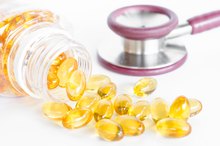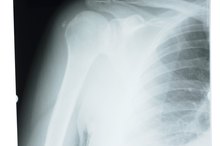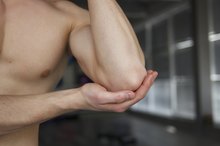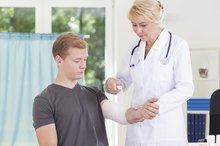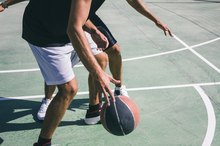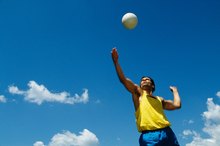Shoulder Pain After a Workout
The shoulder is made up of the collarbone, shoulder blade and the upper arm bone. Upper body workouts or sports that require the use of your arms put your shoulders at risk for injuries. If you get shoulder pain after a workout, immediately stop the exercise and consult a physician. Pain indicates that something is wrong, and only a doctor can determine what the issue is.
Shoulder Joint Tear
Repetitive shoulder motion or acute trauma may cause a tear in the shoulder joint. Trauma may include falling on your arm when it is outstretched, a sudden pull, experiencing a direct blow to your shoulder and violently reaching overhead. Wrestlers and throwing athletes are particularly at risk. Symptoms may include pain, losing strength, shoulder instability, a reduction in range of motion and locking, popping, catching and grinding in the affected shoulder. Treatment typically includes a type of anti-inflammatory medication, physical therapy and possibly surgery.
- Repetitive shoulder motion or acute trauma may cause a tear in the shoulder joint.
- Symptoms may include pain, losing strength, shoulder instability, a reduction in range of motion and locking, popping, catching and grinding in the affected shoulder.
Rotator Cuff Tendinitis
Can Fish Oil Supplements Cause Joint Pain?
Learn More
This condition is characterized by the tendons in your shoulder becoming inflamed. Throwing a ball repeatedly is the most common cause, but lifting weights above your head, regular swimming, pitching in baseball or softball, or playing tennis can also cause the condition. Symptoms include pain when you move the affected shoulder, weakness and difficulty using the affected shoulder. Treatment typically includes rest, icing, nonsteroidal anti-inflammatory drugs and physical therapy. If the pain is severe, your doctor may prescribe steroid injections. Surgery may be necessary if your rotator cuff is completely torn.
- This condition is characterized by the tendons in your shoulder becoming inflamed.
- Surgery may be necessary if your rotator cuff is completely torn.
Shoulder Impingement
This is one of the most common reasons that adults experience shoulder pain, according to the American Academy of Orthopedic Surgeons. This condition is characterized by pressure on your rotator cuff from an area of your shoulder blade when you lift your arm. Athletes commonly experience this, especially those who swim, play tennis or baseball, due to frequently lifting their arms above their heads. Symptoms may include pain, radiating pain, local tenderness, and swelling and stiffness. As this condition becomes worse, you may lose range of motion and strength. In the most advanced cases, severe tenderness, limited movement, pain and frozen shoulder may occur. Treatment usually begins with resting the affected shoulder, stretching exercises, local cortisone and anesthetic injections into the affected shoulder, and nonsteroidal anti-inflammatory drugs. When these treatments fail, surgery may be necessary.
- This is one of the most common reasons that adults experience shoulder pain, according to the American Academy of Orthopedic Surgeons.
- As this condition becomes worse, you may lose range of motion and strength.
Dislocated Shoulder
Can I Lift Weights With a Glenoid Labrum Tear?
Learn More
This is a traumatic injury and it is very common. The shoulder's high mobility makes it vulnerable to dislocation. A dislocation means the upper arm bone is forced out of the shoulder joint. A blow to the shoulder, or a violent pull can cause this. Symptoms may include a “popping” feeling, severe pain, a deformed look, swelling and bruising. Treatment includes using manipulation to put the shoulder back in place. Once this is done, treatment may include medications, immobilization, physical therapy, and in some cases, surgery is necessary, according to the Sports Injury Clinic.
- This is a traumatic injury and it is very common.
- A dislocation means the upper arm bone is forced out of the shoulder joint.
Related Articles
References
- American Academy of Orthopaedic Surgeons: Shoulder Joint Tear
- MedlinePlus: Rotator Cuff Tendinitis
- American Academy of Orthopaedic Surgeons: Shoulder Impingement
- Sports Injury Clinic: Shoulder Dislocation
- American Academy of Orthopedic Surgeons. (2018). Arthritis of the Shoulder. https://orthoinfo.aaos.org/en/diseases--conditions/arthritis-of-the-shoulder
- Kadi R, Milants A, Shahabpour M. Shoulder Anatomy and Normal Variants. J Belg Soc Radiol. 2017;101(Suppl 2):3. doi:10.5334/jbr-btr.1467
- Murphy RJ, Carr AJ. Shoulder pain. BMJ Clin Evid. 2010;2010:1107.
- Singh B, Bakti N, Gulihar A. Current Concepts in the Diagnosis and Treatment of Shoulder Impingement. Indian J Orthop. 2017;51(5):516-523. doi:10.4103/ortho.IJOrtho_187_17
- Minns lowe CJ, Moser J, Barker K. Living with a symptomatic rotator cuff tear 'bad days, bad nights': a qualitative study. BMC Musculoskelet Disord. 2014;15:228. doi:10.1186/1471-2474-15-228
- Cleveland Clinic. Frozen Shoulder. 2019.
- De carli A, Pulcinelli F, Rose GD, Pitino D, Ferretti A. Calcific tendinitis of the shoulder. Joints. 2014;2(3):130-6.
- Raney EB, Thankam FG, Dilisio MF, Agrawal DK. Pain and the pathogenesis of biceps tendinopathy. Am J Transl Res. 2017;9(6):2668-2683.
- Alentorn-geli E, Assenmacher AT, Sánchez-sotelo J. Distal biceps tendon injuries: A clinically relevant current concepts review. EFORT Open Rev. 2016;1(9):316-324. doi:10.1302/2058-5241.1.000053
- Wilk KE, Macrina LC, Cain EL, Dugas JR, Andrews JR. The recognition and treatment of superior labral (slap) lesions in the overhead athlete. Int J Sports Phys Ther. 2013;8(5):579-600.
- Chillemi C, Franceschini V. Shoulder osteoarthritis. Arthritis. 2013;2013:370231. doi:10.1155/2013/370231
- Warth RJ, Martetschläger F, Gaskill TR, Millett PJ. Acromioclavicular joint separations. Curr Rev Musculoskelet Med. 2013;6(1):71-8. doi:10.1007/s12178-012-9144-9
- Defroda SF, Nacca C, Waryasz GR, Owens BD. Diagnosis and Management of Distal Clavicle Osteolysis. Orthopedics. 2017;40(2):119-124. doi:10.3928/01477447-20161128-03
- Dumont GD, Russell RD, Robertson WJ. Anterior shoulder instability: a review of pathoanatomy, diagnosis and treatment. Curr Rev Musculoskelet Med. 2011;4(4):200-7. doi:10.1007/s12178-011-9092-9
- Chalidis B, Sachinis N, Dimitriou C, Papadopoulos P, Samoladas E, Pournaras J. Has the management of shoulder dislocation changed over time? Int Orthop. 2007;31(3):385-9. doi:10.1007/s00264-006-0183-y
- Armstrong A. Diagnosis and clinical assessment of a stiff shoulder. Shoulder Elbow. 2015;7(2):128-34. doi:10.1177/1758573215569340
- Dee SW, Kao MJ, Hong CZ, Chou LW, Lew HL. Chronic shoulder pain referred from thymic carcinoma: a case report and review of literature. Neuropsychiatr Dis Treat. 2012;8:399-403. doi:10.2147/NDT.S36476
- Park SI, Choi YK, Lee JH, Kim YM. Effects of shoulder stabilization exercise on pain and functional recovery of shoulder impingement syndrome patients. J Phys Ther Sci. 2013;25(11):1359-62. doi:10.1589/jpts.25.1359
- Block JE. Cold and compression in the management of musculoskeletal injuries and orthopedic operative procedures: a narrative review. Open Access J Sports Med. 2010;1:105-13.
- Shih YF, Liao PW, Lee CS. The immediate effect of muscle release intervention on muscle activity and shoulder kinematics in patients with frozen shoulder: a cross-sectional, exploratory study. BMC Musculoskelet Disord. 2017;18(1):499. doi:10.1186/s12891-017-1867-8
- Razmjou H, Robarts S, Kennedy D, Mcknight C, Macleod AM, Holtby R. Evaluation of an advanced-practice physical therapist in a specialty shoulder clinic: diagnostic agreement and effect on wait times. Physiother Can. 2013;65(1):46-55. doi:10.3138/ptc.2011-56
- Sun Y, Chen J, Li H, Jiang J, Chen S. Steroid Injection and Nonsteroidal Anti-inflammatory Agents for Shoulder Pain: A PRISMA Systematic Review and Meta-Analysis of Randomized Controlled Trials. Medicine (Baltimore). 2015;94(50):e2216. doi:10.1097/MD.0000000000002216
- Moore N, Pollack C, Butkerait P. Adverse drug reactions and drug-drug interactions with over-the-counter NSAIDs. Ther Clin Risk Manag. 2015;11:1061-75. doi:10.2147/TCRM.S79135
- Vyvey M. Steroids as pain relief adjuvants. Can Fam Physician. 2010;56(12):1295-7, e415.
- American Academy of Orthopedic Surgeons. (2018). Arthritis of the Shoulder.
- Fields KB. (2018). Evaluation of the adult with shoulder complaints. In: UpToDate, O'Connor, FG (Ed), UpToDate, Waltham, MA, 2014.
- Tonino PM, Gerber C, Itoi E, Porcellini G, Sonnabend D, Walch G. Complex shoulder disorders: evaluation and treatment. J Am Acad Orthop Surg. 2009 Mar;17(3):125-36.
Writer Bio
Rose Kitchen is a freelance medical writer pursuing a bachelor's degree in sociology and education. She has a nursing background and is going back to nursing school in September 2011 for her R.N. Kitchen holds a certificate in anatomy and physiology and English and is pursuing certificates in natural and alternative medicine, fitness and nutrition and sports nutrition.
